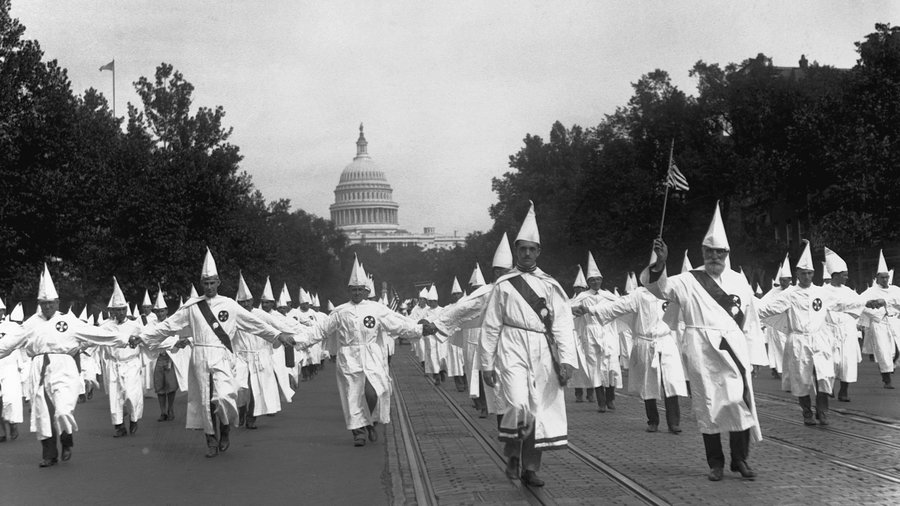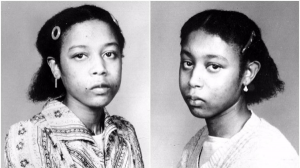Since its origins, the infamous Ku Klux Klan has influenced the attitudes and views of many Americans. The KKK will forever be recognized as the largest political hate group in United States history. Despite the rise and fall of the Klan, it wasn’t until the 1920s that it rose to its highest peak in prominence. During this time period, there was exponential growth in both membership in and support for this notorious cult. The KKK was a growing cult in the 1920s because it instilled religious beliefs, terror, and a skewed view of a better America into the minds of its members through its propaganda of racial superiority.
The original KKK arose during the Reconstruction era of the 1860s and 1870s, and was primarily aimed at restoring the antebellum racial hierarchy to the South. However, it declined in the 1870s due to the passing of legislation aimed at stopping Klansmen’s voter intimidation activities and associated hate crimes. With the end of Reconstruction in 1877, and the passage of Jim Crow laws throughout the South, Klan activity and Klan membership declined. But the cult began a strong resurgence in 1915, with membership skyrocketing to nearly four million by the year 1920.1 This time, the focus of their efforts was aimed at “Americanizing” people by promoting the Constitution, the flag, and the Bible.2 This white supremacist organization lashed out at any group whose ideals conflicted with their own, especially that of African Americans, Catholics, and Jews.

The revival of the Klan was led by its notorious second Grand Wizard (the KKK’s primary leader), William J. Simmons, who was a preacher, a veteran, and an extreme white supremacist.3 He was inspired to reorganize the Klan after watching the silent movie Birth of a Nation, which depicted the Klan as a saving grace, defending the birthright of white southerners and greatly enhancing the public opinion of the cult.4 The religious implications of the KKK stemmed from the teachings of Simmons. Not only were his sermons effective at grasping the hateful minds of Klan members, but he truly convinced them that they were doing the work of God; his credibility led him to a position of power. In fact, one could not join the Klan unless one practiced “militant Christianity,” living in such a way as to be an example to others by following laws, abstaining from drinking, gambling, infidelity, and by not neglecting one’s family. Members were to attend church services regularly, always adhering to the foundations of the Christian faith.5 In addition to this, the KKK burned crosses, often arguing that it was to symbolize the spread of Jesus’ light; it was a symbol aimed to “drive away darkness and gloom.”6 The heavily emphasized morals and negative attitudes toward others are what drove the cult’s frame of thought. Often interpreted in a hateful manner, the religious implications instilled by the KKK’s leaders too often brewed inaccurate thoughts in the minds of its followers; thus, many assumed that the answer to their problem was to commit radical acts of terror.

In addition to their cloaking themselves in the trappings of Christianity, the Klan also used terror tactics to instill fear into both its own members and to those it targeted. The members saw themselves as vigilantes in the restoration of justice—using intimidation, violence, and terror to prevent people of color from attaining any sort of social status or political power. They burned crosses, led beatings, committed assassinations, lynchings, and much more.7 While the symbol of the KKK, the burning cross, held religious connotations for its own members, it was also used as a form of intimidation. They used this symbol of a burning cross to terrorize African Americans.8 In addition to intimidating African Americans, the Klan also targeted Catholics, and had a particularly strong concern with this group due to the fact that they practiced a “different religion” from their own. The motivation for this anti-Catholicism is deeply rooted in American history, going all the way back to colonial times. And with the dramatic increase of Catholics immigrating from Ireland, Italy, and Germany in the nineteenth century, anti-Catholicism was a mainstay throughout American life in the early decades of the twentieth century.9 With the ethnic, social, and racial diversity of American life, tensions continued to heighten among the opposing whites who sought to rid America of these many “outsiders” — a long-held notion in American society. In using both verbal and physical threats, the terror inflicted by the cult caused people to fear the power of the invisible empire that was the KKK.
The idea of creating a better America was yet another reason for the Klan’s rise to prominence in the 1920s. The KKK fought for stricter enforcement of prohibition laws, sought to eliminate political corruption, and wanted to eradicate any form of immigration. Any seemingly “foreign-born” citizen that crossed the path of a klansman was deemed un-American. The Klan assumed they were doing the nation its due diligence in suppressing these “outsiders.” At its peak, the Klan even managed to get political leaders to seek their support and endorsement, since many Americans at this time sympathized with the Klan and its mission.10 And as membership grew, so did their influence. Their opposition to non-whites and to immigration helped to secure the passage of strict quotas on those seeking to come to America.11 The KKK was influential in more ways than one — their power reigning heavily on American society. Even today, white supremacists seek to have their voices heard and their views seen as legitimate. The fight for racial toleration is certainly far from over.

On the other hand, some say that the resurgence of the KKK in the 1920s was due primarily to the effects of industrialization, urbanization, and immigration on society. White Americans became uneasy about immigration and “outsiders” taking American jobs. Many could not stand the idea of “those people” diluting the “racial purity” of American society. But the idea of racial purity is a myth–yet a strong one that many white racists wish to be true. The original soil of America was populated by immigrants and natives alike; whites simply claimed it as their own, as they were to be the guardians of a “city on a hill” and as part of their “manifest destiny” to be the bearers of a supreme culture and society.12 Those that looked to this cult to justify their own beliefs do not parallel with what it means to be an independent individual in American society. The people they were trying to drive out had just as much freedom to be in the United States as they did. Others in support of the Klan also claimed that Simmons was, in fact, preaching for the betterment of society, and that he never resorted to violence to solve problems; though this may seem true, Simmons was actually insinuating his own, twisted version of the word of God, often emphasizing ideas of white supremacy and racial segregation as if that was God’s will. In a pamphlet he wrote in the early nineteenth century, he even states that the primary goal of the organization is to preserve ideals of pure Anglo-Saxon civilization, and many claimed he preached themes of being a pro-American leader by hinting in his sermons that any person in opposition to traditional thought of Anglo supremacy was unwelcome, and simply un-American.13 He silently, yet deviously, instilled discrimination into the Klan’s members. It was even noted that Catholic priests, Protestant ministers, and Jewish rabbis came forward to condemn the organization and its false teachings.14 It seems that the religious implications, terroristic acts, and the skewed ideals used in order to insinuate the making of a better America are contradictory to both the Klan’s mission and the symbols they claimed to uphold.
With a religious basis, the Klan movement emphasized legal and political approaches to solving the “moral crisis” in 1920s America.15 The cult rose to prominence in the 1920s because of their religious, terroristic, and “ideal American” implications; however, their resurgence only served as a detriment. The second coming of the Klan was significant in that it rose to its highest peak in prominence. The KKK’s second coming only continued to fuel the long-held idea of hatred and discrimination that still lingers in the minds of many today.
- Khan Academy, 2016, s.v. “The Reemergence of the KKK,” by Dr. Michelle Getchell. ↵
- David A. Horowitz, Inside the Klavern: The Secret History of a Ku Klux Klan of the 1920s (Carbondale: Southern Illinois University Press, 1999), 10. ↵
- David A. Horowitz, Inside the Klavern: The Secret History of a Ku Klux Klan of the 1920s (Carbondale: Southern Illinois University Press, 1999), 11. ↵
- Roland G. Fryer, “Hatred and Profits: Under the Hood of the Ku Klux Klan,” Quarterly Journal of Economics 127, no. 4 (November 2012): 12. ↵
- Holley Donald, “A Look Behind the Masks: The 1920s Ku Klux Klan in Monticello, Arkansas,” The Arkansas Historical Quarterly no. 2 (2001): 19. ↵
- David Cunningham, “Top 5 Questions About the KKK,” PBS, 2013. Accessed March 12, 2018. http://www.pbs.org/wgbh/americanexperience/features/klansville-faq/. ↵
- Khan Academy, 2016, s.v. “The Reemergence of the KKK,” by Dr. Michelle Getchell. ↵
- PBS, 2013, s.v. “Top 5 Questions About the KKK,” by David Cunningham. ↵
- Mark Paul Richard, Not a Catholic Nation: The Ku Klux Klan Confronts New England in the 1920s (Amherst: University of Massachusetts Press, 2015), 11. ↵
- American Decades, 2001, s.v. “After the Great War: Nativism and the Ku Klux Klan,” by Judith S. Baughman, et.al. ↵
- Gale Encyclopedia of American Law, 2011, s.v. “Ku Klux Klan,” by Donna Batten. ↵
- Khan Academy, 2016, s.v. “The Reemergence of the KKK,” by Dr. Michelle Getchell. ↵
- William J. Simmons, “Pamphlet for the Ku Klux Klan Written by Colonel William Joseph Simmons,” Smithsonian, 2017. Accessed April 6, 2018. https://nmaahc.si.edu/object/nmaahc_2011.155.15. ↵
- Khan Academy, 2016, s.v. “The Reemergence of the KKK,” by Dr. Michelle Getchell. ↵
- Holley Donald, “A Look Behind the Masks: The 1920s Ku Klux Klan in Monticello, Arkansas,” The Arkansas Historical Quarterly no. 2 (2001): 14-15. ↵




122 comments
Hunter Stiles
First, Congratulations on an outstanding article. I think this is a topic that all of us stereotype with minimal knowledge without knowing the actuality of such a horrific group of individuals.
This article that discusses the Ku Klux Klan’s activities was well written and educational. It discussed the group’s hatred for others as well as how it was displayed through terror tactics against both its own members and those it targeted. Their treatment of individuals is harsh and discriminatory; they especially singled specific religions and races such as Catholics and people of color. Knowing a bit about the Klan before reading the story led me to the conclusion that this organization is made up of selfish individuals who are unwilling to modify their views on society.
I think that this article was extremely purposeful! Congratulations once again!
Iris Reyna
Good job on the article, informative and educational and was put together nicely. It did a good job of addressing one of America’s most known cults, the KKK. I’m amazed how people’s minds can be altered with sermons and believe that they are doing God’s will. They did so many horrible things to innocent people all because they had different opinions about the world and that it should be cleansed of “those people”. It’s sad that this is a part of our history and we need to teach our future generations to prevent our history from repeating itself.
Sierra Christa
This article was very informative. The biggest thing that you highlighted is that the KKK was not only targeting people of color. I had no idea they targeted Catholics and Jews simply because they were not the same religion. The irony of them claiming to be a Christianity organization and being the largest hate group is unreal. Their reemergence was because a multitude of reasons and your article did a fanatic job with highlighting this.
Danielle Sanchez
This article contained great images that carried the story along. The Ku Klux Klan rose to its highest peak in the 1920s. The Ku Klux Klan was a cult that continued to grow in the 1920’s. This cult contained the same religious beliefs and contained a skewed view of what they deemed a better America was in their minds. The KKK was reborn in 1915 by William J. Simmons.
Guiliana Devora
This was a very informative article about the reemergence of the KKK. It still baffles my mind today about how people could think this way and follow the ideals of the clan. Their whole ideal was to purify America but like the article said America was not founded by just white people but by a whole plethora of minorities and religions, so America is meant for everyone and not just one group. Also to think that you are superior to someone else just because of the color of your skin is just insane to me.
Olivia Gray
Very well written article! It was very descriptive and had a great structure to it. It was very interesting to read about the KKK and how cruel they were. I always thought that they only targeted African Americans, but so were catholics and Jews. I never knew the KKK members were ” religious” which was why they thought it was okay to kill African Americans. I can’t even believe that people thought the KKK was good and that people were apart of it. Reading about it makes me realize how terrible it actually was.
Gabriella Galdeano
This article was very well written. The attention to detail was good throughout the article. It is hard to believe that a silent movie is what led to the resurgence of the KKK. Simmons’ use of Christianity to fit the skewed beliefs of that hate group was surprising. What I found even more surprising was that Americans sympathized with their mission. Simmons knew exactly how to influence Americans with his warped teachings.
Mark Gallegos
This is a great informational article that does a good job of explaining the resurgence of the KKK and their terror methods. I had not known that they also targeted other religious groups like Catholics and Jews, as well as supporting eugenic/Anglo supremacy ideas. You did a great job in formatting this interesting topic into a well structured story.
Geraldine Fry
I was surprised to read that the clan was able to resurface in 1920, I only thought that severe racism like that existed in 1800. I also didn’t know that the KKK was religious and that they believed it was moral to kill African Americans. I can’t believe someone would believe killing and torturing others is moral, good, and Christian. I can’t believe they were of Christian faith and attended church regularly. They also hate Catholics because they are part of a different religion. I thought Catholicism was just a different branch of Christianity. I guess I didn’t know anything about the KKK until reading this.
Abbey Stiffler
The KKK was not opened minded one bit. It was their way or the highway. The fact that they inflicted violence on those who did not agree with them sickens me. It does not make sense in my head how this group preaches the word of God, but the actual word of God had nothing to do with their actions. I think that this should be more of a topic people learn about as it tells how hate groups start.